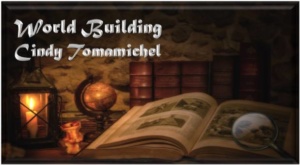Designing a new world with its own creatures and plants is a lot of fun. There are so many resources available online that research can be a bottomless pit. However, this depth of knowledge will shine through in your writing. Just try not to show off your knowledge with vast info dumps, not all readers will be as enthralled with the details of amphibian evolution as you might be. You can always list your references in an appendix, and discuss it at more length there, or mention your fascination in your blogs and social media for instance.
 Evolution is the process of change, as mutations in plants and creatures develop. The passing on of these mutations relies on successful reproduction. Success is dependent on the ability to find food and a mate. Much of this then relies on exploiting a niche in the environment that has less competition or developing a tool or method that is more successful than competitors. So, in fiction, the area is ripe for your imagination to populate your world. Goodness knows, there are enough fascinating examples of environmental niches in our world to provide some excellent examples.
Evolution is the process of change, as mutations in plants and creatures develop. The passing on of these mutations relies on successful reproduction. Success is dependent on the ability to find food and a mate. Much of this then relies on exploiting a niche in the environment that has less competition or developing a tool or method that is more successful than competitors. So, in fiction, the area is ripe for your imagination to populate your world. Goodness knows, there are enough fascinating examples of environmental niches in our world to provide some excellent examples.
Start with the geography. Is it an earth like planet or something quite different? Does it need terraforming? Robert Heinlein in “Farmer in the Sky” did a wonderful job in depicting the job of a farmer on Ganymede, with all the social problems set against the issues of terraforming a moon. If it is a fantasy, is it Earth in the past or a parallel mythical past Earth? Against Earth normal plants and animals you can have other creatures such as dragons, but do spend some time thinking how they would fit into the overall environment. Matthew Reilly in “The Great Zoo of China” used the plethora of earth legends to speculate the existence of dragons, and then used that to craft a full on action novel that makes you wonder if it could be real. Michael Crichton’s “Jurassic Park” series and “Congo” rely on animals, whereas his novels like “Prey” speculate on future mutations from lab experiments.
But mutations can go another way. As many post apocalypse writers have speculated, radiation, chemicals, lab experiments gone wrong, or plagues provide a fine reason for genetic change. H.G.Wells wrote one of the first novels of lab experiments gone hideously wrong in “The Island of Dr. Moreau” in 1896. John Wyndham, “The Chrysalids” is a fine example of post-apocalyptic mutations and the society that grows from it. The Shannara chronicles by Terry Brooks also develops this theme into separate races and societies over an long time span. Conan spent quite a lot of time fighting sentient apes that had been mutated by sorcerers, or remnants of ancient races of lizard people.
Predator and prey relationships are another feature that can be included. Large cats -sentient or otherwise- are popular, and used by Andre Norton in space and fantasy, as well as “The Gandalara Cycle” by Randall Garrett. But predators can come in many variations, with giant worms popular foes in Conan novels, and ravening insects in the terrible schlock horror books of the 80’s. They can be new ones, adapted to your environment , or known beasts with additional features. Giant spiders are a never ending source of horror for young wizards such as Ron Weasley, as well to hobbits like Frodo and Bilbo. One source of inspiration can be the microscopic world, and imagining them to human size.
Plants are another feature of interest in building a world. They are part of the landscape, and can be used to add detail and drama to a scene. David Eddings in “Redemption for Althalus” uses devil weed – a viciously thorny plant as a barricade in a siege and it is also medicinal. Have your hero trudge through stinging nettles, or feel the texture of the rough bark of a tree while their heart pounds watching the enemy. Walk through wild herbs and smell them in the air, or gather them and use them to wrap food in to cook at night, as Ayla does in “Clan of the Cave Bear” Earth Children series. Plants also have their own self defence mechanisms, with the carnivorous plants an excellent area to explore for ideas. There is a collection of short stories by Carlos Castaneda that covers a range of plant horror stories. Excellent, if slightly haunting. The 80’s also did a lot of research into plant auras and responses to voice, music and pain, which might also be a good area to find odd ideas. Alan Dean Foster’s “Midworld” uses plants as almost another character.
So a book can be richly imagined using the lessons of evolution of our planet, and the studies of other planets. The extremes of life on our earth such as hot pools, underground caverns, deep sea trenches and the microscopic world can provide a wealth of ideas. But don’t forget there must be a story. An imaginary world is a backdrop, and let your characters shine against it.


Interesting post.